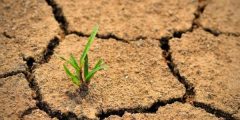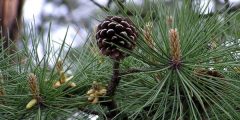What are the stages of tree growth?
Like other living organisms, trees have a life cycle that begins from the seed and passes through many stages until death. Because trees are renewable plants, they begin a new life cycle either artificially through planting and transplanting, or naturally through seeds. As for the stages of the tree’s life cycle, they are:
the seed
The tree's life cycle begins with the seed that came from the female and male fruit-producing organs in the tree. Seeds differ from one tree to another in their shape, color, size, and weight, and they also differ in their location. For example, the seed may be inside an outer shell, such as walnuts and walnuts. pecan, or in the pulp of the fruit; Like black cherries and raspberries, it is moved from one place to another by wind, water, animals, and humans. When the appropriate place and environment is available for the seed to grow, it will begin to do so.
budding
The seeds have within them an embryo that begins to grow if it is found in an environment suitable for growth. It expands and penetrates the seed cover, relying on the food reserves present in it. At this stage, the roots begin to grow downward in search of water and nutrients and to stabilize the buds, so the buds begin their growth upwards. In search of sunlight until the leaves grow and develop to be able to manufacture their own food through photosynthesis.
Read also:The relationship between vegetation and terrain
the plant
The bud continues to grow and the woody characteristics of the stem begin to develop. At this stage, the soft green stem begins to harden and its color begins to change, developing a thin outer shell called bark. The leaves continue to grow in search of light, and the roots expand and branch downward, taking on a tree-like shape. Upside down with a flattened top.
The roots of most plants are located in the upper part of the soil, which helps them obtain water and food, and at the same time enables them to obtain the necessary amount of oxygen to survive. At this stage, the plant faces a number of challenges, as it competes with the rest of the plants and trees. Existing in the same space on water, sunlight, and available food, the plant’s transition to the next stage of its life cycle means that it overcomes other threats; Such as floods, drought, ice, snow, and other dangers.
The seedling
The plant enters the seedling stage when its diameter reaches between 2.54 and 10.16 cm at a height of 137.16 cm. This is the standard height of the plant at which the diameter of the tree is measured, or what is called the diameter at breast height. The seedling is not considered mature enough. It is sufficient to produce fruits, but it is characterized by its rapid growth in this stage. As for the risks that trees face in this stage, they are similar to those they face in the sprouting stage.
Read also:Impact of global warming on agriculture
maturity
The tree remains in the seedling stage as long as it does not produce fruits, seeds, or flowers. Whenever this seedling begins to bear fruit, this means that it moves to the adult stage to become a mature tree. For many trees, this matter may take a decade or two, as it takes For some trees, such as oaks, for example, they last for 40 years.
The tree reaching this stage does not mean that it has stopped growing; Rather, it continues to grow and produce fruits and seeds for a long period of time, estimated at decades or even hundreds of years. At this stage, the tree reaches the peak of its production, and remains in this stage until its production begins to decline and it enters the final stage of its life.
deterioration
The tree finally reaches this stage when external pressures are able to defeat it, making it more vulnerable to insects and diseases. Among the most important main reasons causing these pressures are:
- Planting the tree in places that are not suitable for it, and this is represented by many examples: The most important of them: planting trees in basic soil, although they grow better in an acidic environment.
- Plant trees that prefer hot environments in cool environments, or trees that grow best in moist soil in dry soil.
- Planting trees whose ideal growth requires full sunlight in the shade of other trees.
- Planting trees known to grow significantly in size in confined spaces; Such as planting an oak tree and other trees known for their large tops and extended roots in the soil in an agricultural pit with dimensions of 1.2 m * 1.2 m located within a sidewalk or street. In general, trees that are planted in such conditions will not live long.
- Planting trees sensitive to air pollutants in areas with high levels of pollutants.
- Planting trees that need dry soil in lowlands where swamps are common.
- Planting trees in places crowded with other trees, which means intense competition for sources of water, oxygen, and sunlight. Although some trees will eventually dominate many sources, the competition will slow down their growth, and in the end the tree may fall under pressure from external factors. .
- The harsh conditions that trees are periodically exposed to; Such as floods, severe drought, epidemics, and insects.
- Various construction operations that may cause soil compression by construction machinery, root destruction due to soil removal operations, or root suffocation as a result of the accumulation of waste resulting from construction operations.
- Soil compaction around the roots may also be caused by humans. Children's swings or pet homes can cause this. Changes in soil condition may also occur as a result of adjusting the soil's pH, in order to create green areas, which may place trees in the area under Pressure that eventually leads to its deterioration.
- Changes in water drainage methods modify the slope of the ground, which may move water away from tree locations, causing a decrease in the level of moisture available to trees.
- Building sidewalks, walkways and streets in urban cities, which may lead to negative changes in the environment in which some perennial trees grow.
Symptoms of deterioration are usually represented by slow growth and development of the tree. These symptoms begin to appear in the upper parts of the tree and then begin to creep downward, with the exception of some species in which symptoms may begin to appear in the lower parts of the tree, such as conifers. One of the most important symptoms that appear on the tree at this stage is :
Read also:Preserving planet Earth- The leaves are pale green or yellow.
- Delayed appearance of spring growth.
- Burning of tree leaves.
- Decreased growth rates of branches and tree trunk.
- Leaves fall earlier than expected.
- Leaves lose their color early in the fall.
Decomposition
Trees may live for thousands of years, but like other living organisms, their life cycle must end one day, and the owners of dead trees may want to get rid of them, but in this case trees are of great importance to the forest ecosystem, and they are also considered a suitable habitat for many... Animals, in addition to being a rich source of nutrients that will return to the soil when they decompose, and it can be said in general that humans can delay the tree’s arrival at this stage early in its life, by avoiding environments that are not suitable for agriculture and avoiding planting in areas crowded with other species.
Factors affecting tree growth
Sun light
Trees need sunlight to carry out the process of photosynthesis, through which glucose is produced, which is necessary for the growth of trees and for the vital processes within them. Trees in one area compete for the sunlight reaching them, as tall trees with extended branches work to block and reduce the rays reaching the shaded trees. Which may lead to reducing or stopping the growth of shade trees, which ultimately leads to their death.
water
The importance of water for trees is that it is an important element for plant metabolism, in addition to its basic role in transporting minerals and nutrients to the different parts of the tree. About 95% of the water inside trees is lost during the evaporation process in order to cool the tree’s leaves, while the remaining 5% is lost. The remainder is used in the processes of photosynthesis and respiration.
During the process of photosynthesis, the pores of the leaf open through which carbon dioxide can enter and oxygen can be removed. As a result of these pores being open, the water remaining in the tree is usually lost through them in a process called transpiration. To compensate for the lost water, the tree begins to draw water from the soil through Roots to leaves.
If the soil is not moist enough to compensate for the lost percentage of water, the trees close the stomata in the leaves, which means the process of photosynthesis and growth stops, which may lead to the trees withering, premature leaf fall, yellowing, and the death of the tree’s branches, making it more vulnerable to insect attack. .
Nutrient elements
Trees need food that contains the six major nutrients in large quantities. These elements are: nitrogen, phosphorus, potassium, calcium, magnesium, and sulfur. They also need smaller nutrients in smaller quantities, such as iron, manganese, zinc, boron, and chlorine. These nutrients play important and key roles in many physiological processes in plants, such as photosynthesis, growth processes, nitrogen fixation, respiration, water absorption from the soil, and others.
Trees can carry out the previous operations well and with high efficiency when nutrients are available in appropriate quantities for them, which they usually obtain sufficient of from the soil. The percentage of nutrients present in the soil depends on the rocks that formed this soil, on the percentage of decomposed organic matter in it, and on the amount Elements deposited from the atmosphere. As for nitrogen, the plant obtains enough of it from rain.
air
Trees need carbon dioxide for photosynthesis and also need oxygen for breathing at night. Trees obtain their need for oxygen and water through the roots, and about 90% of tree roots are located at a depth of 1 meter of soil, meaning that the roots that feed the plant are usually found within the first 30.5 cm of the surface soil, where air and water are available in good quantities, and the amount depends on The roots expand in the soil if the appropriate amount of air and water is available. The roots may expand horizontally by 2-3 times the width of the tree crown.
There are many factors affecting the ability of roots to absorb oxygen and water from the soil, the most important of which are beneficial fungi such as mycorrhizae, which colonize the roots of most tree species. These fungi work to increase the ability of the roots to absorb water and minerals, in addition to their role In protecting the roots from many diseases, on the other hand, soil compression restricts the growth of the roots. It also reduces the number and size of voids in the soil, which means less water stored inside it, and restricting the transmission of air through the pores.
the soil
Soil is an important factor in determining the future and growth of trees. There are many matters related to the soil that affect the tree either negatively or positively, such as the acidity or alkalinity of the soil, the level of salinity and the degree of water saturation, the characteristics of the surface soil and what is beneath it, the type of soil and its components, whether it is clay soil, sandy soil, or mixed soil, and many other characteristics. Which has a huge impact on trees.









